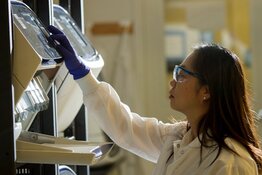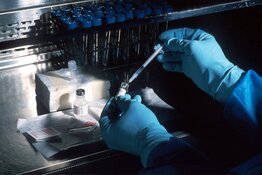The Life Sciences Report: Alain, you have compared the current stage in the development of the stem cell and regenerative medicine industry to the beginning of the monoclonal antibody revolution. Companies formed to leverage stem cell technology have been around now for three decades. When are we going to start to see the approval, marketing and reimbursement of some of these technologies?
Alain Vertès: I am quite optimistic we'll see these things soon, I have to say.
It's true that there is a very nice parallel between the technology of stem cell therapeutics and the technology of monoclonals. A historic look at monoclonals is a very insightful way to understand the stem cell industry, in the sense that it took about 25 years for monoclonal antibodies to emerge as a mainstream product category. As recently as 2007, there were only a handful of companies with double-digit sales derived from monoclonal antibody-based therapies. The transition and penetration of this new technology class started quite slowly. I think we are witnessing something similar with stem cells and regenerative medicine.
"Athersys Inc.'s MultiStem could very well be among the first few products approved in Japan."
Considering only mesenchymal stem cells, I would say that by 2017 we should have good clarity regarding deployment in major markets. First of all, we have Prochymal (allogeneic human mesenchymal stem cells; [remestemcel-L]), a product developed by Osiris Therapeutics Inc. (OSIR:NASDAQ) and acquired by Mesoblast Ltd. (MSB:ASE; MBLTY:OTCPK) in October 2013. Mesoblast is continuing the development of Prochymal in refractory Crohn's disease. It has been conditionally approved in 2012 in Canada and New Zealand for the treatment of acute graft-versus-host disease in steroid-refractory pediatric patients, and should be deployed in major markets relatively soon, including in Japan, where it is developed by Mesoblast's partner there. I think Prochymal, for this particular indication and for this particular patient population, will be one of the first stem cell therapies to hit the market. Having said that, let's not forget that South Korea has already approved some of these therapies.
It is interesting also to look more closely at what is happening in Japan. That country has a new law that essentially enables companies to more quickly develop and deploy stem cell technologies into the market, as long as safety is demonstrated. This is particularly in response to an aging society, and the observation that conventional pharmaceutical approaches have not satisfactorily addressed a range of indications—for example, stroke as a leading cause of death and disability—that impose high social and financial burdens. Regenerative medicine products could change this. The Japanese parliament enacted the new law in November 2013, revising the Pharmaceutical Affairs law to define new regenerative medicine products. Companies can now get conditional approval for stem cell products after they show safety, like they would in a Phase 2 trial.
"Right now, RepliCel Life Sciences Inc. is positioned with very good potential."
On March 2, Chugai Pharmaceutical Co. Ltd. (4519:TSE) and Athersys Inc. (ATHX:NASDAQ) announced a deal using Athersys' MultiStem (allogeneic multipotent adult progenitor cells) product for the treatment of ischemic stroke. MultiStem could very well be among the first few products approved in Japan. But then again, the law will be beneficial for all stem cell companies, which is very exciting.
TLSR: We are just starting to see oligonucleotides come to the market as approved therapies. It appears to take a quarter of a century for a new technology to move from lab bench to treating patients. Would you agree?
AV: It does appear that way. Hopefully, with the accelerated pathway we're seeing in Japan, novel therapeutics will take a lot less time to get to patients. And even outside Japan, given the number of trials in Phase 2 and Phase 3 that will be reading out this year or next year, we should see some cell therapy products begin to emerge.
TLSR: Unlike cell technologies, the monoclonal antibody industry is relatively straightforward. Monoclonal antibodies act pretty much the same way as small molecules do: They engage or inhibit a protein on a cell membrane to alter signal transduction into and within the cell. With stem cells, aren't we talking about a much more complex system? Cells perform most all metabolic activities, including reproduction. Importantly, they also express multiple genes. Are we talking about apples and oranges here?
AV: I think we can have both perspectives. We can say that stem cells and monoclonals are very much similar in terms of the S-curve of development. Speaking retrospectively, it's quite easy to identify the S-curve that made monoclonal antibody products a reality. When we started with murine (mouse) antibodies, those didn't work because of immune reactions. We had to progress upward on the S-curve from murine to chimeric (combining genetic elements from nonhuman and human) to humanized, and to fully human antibodies. When we reached the last level, the technology became mature enough to penetrate the market. It was only a question of allowing innovation to take over. If we look at stem cells, we see very similar lower stages of S-curve development. The safety of mesenchymal stem cells is now clear. It's a little bit less clear for induced pluripotent stem cells or embryonic stem cell products.
"The market is still not valuing stem cell programs and companies fairly; this is a very exciting time for proposed stem cell therapies."
But there is a difference. For the first time, we have pharmaceutical-like products—these cells—that are able to be implanted and enrich a target microenvironment. Cell therapies represent a critical development in healthcare because we now have a therapy that is going to understand, for lack of a better term—or rather sense, through a complex network of signal transduction relay molecules—the specifics of the microenvironment it encounters when it is implanted or infused. These cells will then respond as well as possible based on the area of the body targeted and, of course, based on the specific disease. We thus have the machinery to develop a fresh salvo and create arrays of cytokine growth factors and beneficial effects. That's what makes cells better at targeting disease.
TLSR: I know you have some thoughts about the failed Athersys/Pfizer Inc. (PFE:NYSE) Phase 2 trial with MultiStem, which was reported at the end of April 2014. This study, randomized and double-blind with 126 patients, failed to meet its primary endpoint of reducing the incidence and severity of adverse events in ulcerative colitis. Did that have a chilling effect on big pharma companies, which saw Pfizer fail in this trial?
AV: I don't think it scared companies away because, regarding stem cell therapies, big pharma is really in the monitoring mode at the moment. Everybody in large pharma understands that emerging technologies will lead to some failures, so that's not a surprise. Going back to monoclonal antibodies, the first 15 clinical trials were failures. That's important to keep in mind, because emerging technologies are very challenging.
"Hopefully, with the accelerated pathway we're seeing in Japan, novel therapeutics will take a lot less time to get to patients."
I don't think the Athersys/Pfizer failure was a dramatic problem. Understand that if we look at the fundamentals and properties of Athersys' cell technology, they are still rock solid. Looking at the details of that Phase 2 trial with MultiStem, Athersys and Pfizer set a very, very high bar for success in terms of trial design. One reason this was so challenging was that they were essentially attempting to treat patients who were very sick, and who had already failed several types of therapy. I don't think this was a major failure for the field of stem cell technology. It's clearly a setback, but it's not a fundamentally worrying setback. I don't think it scared away people.
TLSR: You said the bar was set very high. Do you think the single-infusion design was a problem? That single infusion of cells was intended to treat or alleviate a disease some patients had been suffering with for a decade, and in some cases for half their lives. I don't think a small molecule or even an antibody would be expected to work with a single administration.
AV: That definitely was the case. These patients had chronic moderate to severe disease for an average of ten years, and a single injection may not have been sufficient. Also, maybe the company would need to treat patients earlier in their disease progression. It was a very high bar.
TLSR: Athersys' share price has more than doubled over the last three months. My understanding is that short covering was a contributor to that share-price appreciation, but it's clearly a good sign. Would you summarize your thoughts on Athersys?
AV: The stock price has been recovering from the trial failure. As far as MultiStem goes, it has been found to be safe. I do like this company, and its prospects are quite positive.
TLSR: Can you speak to another company working in the cell therapy space?
AV: Yes. I've looked at RepliCel Life Sciences Inc. (RP:TSX.V; REPCF:OTCQB), and I think it's an interesting company, especially when considering its business model. It has an autologous cell therapy model for hair transplant and Achilles tendinosis. In addition, the company has developed a very clever way to deliver its autologous cells for both of its indications—a dermal injector device. Its business model offers investors a reasonable cost of goods sold (COGS). RepliCel has also established a strategic partnership with Shiseido Company Ltd. (4911:TSE) in Japan. This is a partnership with a very good company. Right now, RepliCel is positioned with very good potential. I do not see any fundamental flaw or problem with this company.
TLSR: It has been a rough year for stem cell companies in general. Many companies working in the space have seen double-digit declines in their stock prices. But there's one company that stands out because of its valuation. Mesoblast had more than a $2 billion ($2B) market cap two years ago. Now it's just $1B. What is going on with Mesoblast?
AV: There has definitely been a group effect with regard to the share prices of all these companies. But the case of Mesoblast is very interesting. The company was at the height of its valuation a couple of years ago, and there was a correction in the stock price, following these systemic trends that you just mentioned. The key question here is whether there is a major, fundamental issue in the company.
The answer is no. There is no flaw in terms of the company's fundamental technology; that technology is rock solid. In terms of practical application, the company is solid as well. If we look at the portfolio of Mesoblast indications, there are several disease areas. The company has immunology, oncology, orthopedics and cardiovascular, and in each one of these indications—all of which are major—you have Phase 2 and Phase 3 programs in progress. The essential question we have to ask is, "What is the real valuation for a company with a portfolio like this?" If we were talking about monoclonal antibodies, the valuation of this company would be significantly more than $10B. If we were looking at comparable pharmas, it would be even bigger.
What I'm trying to say is that the market is still not valuing stem cell programs and companies fairly. I think this is a very exciting time for proposed stem cell therapies. If you look at companies with products on the market for similar disease indications, and compare those valuations to the low valuations of stem cell companies, you can see real value here.
TLSR: Alain, it was a pleasure meeting you.
 Alain Vertès, Ph.D., M.B.A., is managing director of Basel, Switzerland-based NxR Biotechnologies, a consultancy that assists companies in funding, positioning and commercializing biotech products. He is an active business development consultant focused on technology deployment and innovation funding and commercialization. He has contributed to research (molecular biology, microbiology, sustainable chemistry), manufacturing (amino acids, enzymes), contract research (Battelle Memorial Institute, PPD), and strategic alliances in pharmaceuticals (Roche, Pfizer, Lilly), petrochemicals (Mitsubishi Chemical Corp.), industrial biotechnology, public research and consulting. With worldwide experience in partnering and licensing groups of big pharmas, Vertès has led reviews of strategic needs for finding, implementing and managing partnerships, from licensing to M&As. With hands-on involvement in the deployment of radical innovation—for example, bringing to patients disease-modifying, paradigm-changing therapeutics—he has managed major siRNA alliances and has led global therapeutic stem cell initiatives.
Alain Vertès, Ph.D., M.B.A., is managing director of Basel, Switzerland-based NxR Biotechnologies, a consultancy that assists companies in funding, positioning and commercializing biotech products. He is an active business development consultant focused on technology deployment and innovation funding and commercialization. He has contributed to research (molecular biology, microbiology, sustainable chemistry), manufacturing (amino acids, enzymes), contract research (Battelle Memorial Institute, PPD), and strategic alliances in pharmaceuticals (Roche, Pfizer, Lilly), petrochemicals (Mitsubishi Chemical Corp.), industrial biotechnology, public research and consulting. With worldwide experience in partnering and licensing groups of big pharmas, Vertès has led reviews of strategic needs for finding, implementing and managing partnerships, from licensing to M&As. With hands-on involvement in the deployment of radical innovation—for example, bringing to patients disease-modifying, paradigm-changing therapeutics—he has managed major siRNA alliances and has led global therapeutic stem cell initiatives.
Read what other experts are saying about:
Want to read more Life Sciences Report interviews like this? Sign up for our free e-newsletter, and you'll learn when new articles have been published. To see recent interviews with industry analysts and commentators, visit our Streetwise Interviews page.
DISCLOSURE:
1) George S. Mack conducted this interview for Streetwise Reports LLC, publisher of The Gold Report, The Energy Report, The Life Sciences Report and The Mining Report, and he provides services to Streetwise Reports as an independent contractor. He owns, or his family owns, shares of the following companies mentioned in this interview: None.
2) The following companies mentioned in the interview are sponsors of Streetwise Reports: Athersys Inc., RepliCel Life Sciences Inc. Mesoblast Ltd. is not affiliated with Streetwise Reports. The companies mentioned in this interview were not involved in any aspect of the interview preparation or post-interview editing so the expert could speak independently about the sector. Streetwise Reports does not accept stock in exchange for its services.
3) Alain Vertès: I own, or my family owns, shares or options of the following companies mentioned in this interview: Mesoblast Ltd., RepliCel Life Sciences Inc. I personally am paid by the following companies mentioned in this interview: Mesoblast Ltd. My company has a financial relationship with the following companies mentioned in this interview: None. I was not paid by Streetwise Reports for participating in this interview. Comments and opinions expressed are my own comments and opinions. I determined and had final say over which companies would be included in the interview based on my research, understanding of the sector and interview theme. I had the opportunity to review the interview for accuracy as of the date of the interview and am responsible for the content of the interview.
4) Interviews are edited for clarity. Streetwise Reports does not make editorial comments or change experts' statements without their consent.
5) The interview does not constitute investment advice. Each reader is encouraged to consult with his or her individual financial professional and any action a reader takes as a result of information presented here is his or her own responsibility. By opening this page, each reader accepts and agrees to Streetwise Reports' terms of use and full legal disclaimer.
6) From time to time, Streetwise Reports LLC and its directors, officers, employees or members of their families, as well as persons interviewed for articles and interviews on the site, may have a long or short position in securities mentioned. Directors, officers, employees or members of their families are prohibited from making purchases and/or sales of those securities in the open market or otherwise during the up-to-four-week interval from the time of the interview until after it publishes.











































